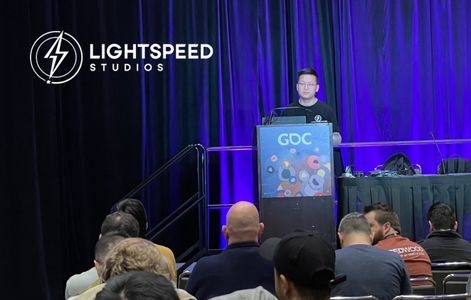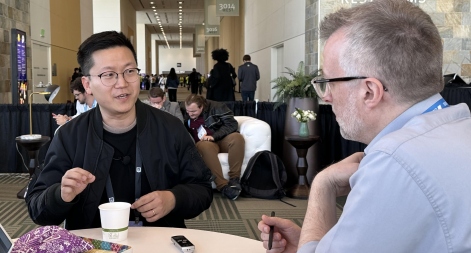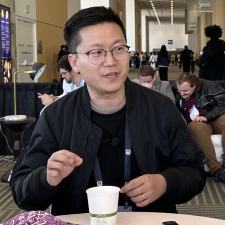Alongside GDC last week, Lightspeed Studios staged its own summit with ten lectures covering its latest best practices in game development. PocketGamer.biz was present at the unveiling of behind-the-scenes details from Lightspeed Studios’ tech strategies, including its work on new optimisation principles for games like PUBG Mobile.
Lightspeed Studios is an international development studio owned by Tencent. It is most famous for co-developing PUBG Mobile with Krafton. However, it has created over 50 games across multiple platforms and genres for over four billion registered users.
We spoke directly to Richard Li, the principal server R&D engineer at Lightspeed Studios. He specialises in building next-gen large-scale online open-world game experiences. With 18 years in the game industry, he’s also worked at Crytek and Epic Games. Now he’s behind Lightspeed Studios’ XPR model, a new way of thinking about large-scale multiplayer open worlds.

As game worlds like PUBG Mobile get bigger and add more features, it becomes more challenging to render them and synchronise data between all the players. The XPR Model tackles the scalability problems of building an open-world game caused by a growing number of players and objects in the game, and by greater computing and synchronisation expenses.
Richard Li’s presentation on XPR was called “Building a Truly Scalable Virtual World”. The model uses philosophies from “many worlds” quantum mechanics to think about how the online environment works. What each player sees is treated as its own version of reality. The game works to synchronise data when two players interfere with each other’s cause-and-effect “light cone”.
A model from modern physics
So how do you make that leap of imagination? “I’ve been thinking about this for quite a while – even before my current work,” Li tells us, sitting down in the Moscone West hall in San Francisco. “The scalability issue is like the Holy Grail for MMORPG games. This is like a very heavily-developed topic since World of Warcraft. People have explored all the possible ways to do things. So when you have to come up with something newer, you must try to think differently.”
XPR splits the game world into bubbles of experience for each player and only resolves them when the experiences interact with each other. As in quantum mechanics, the players operate separately in a superposition state. Then, the waveforms are collapsed (as the metaphor goes) when they interact.
XPR stands for Expand, Propagate, Reduce. In this model, Expand means to split, evolve and entangle the different player experiences; Propagate is to do with "fact travelling" between servers; Reduce means to collapse superpositions back to the classical model.
Sometimes there may be errors in how this resolution happens, but then the XPR system can look back down the timeline and roll back to see what should have happened.
The scalability issue is the Holy Grail for MMORPG games. You must try to think differentlyRichard Li
“There is a trick in the ‘speed of light’ you put in your system,” chuckles Li. “Your system can only go as fast as the communication speed between the servers. So that means you have to carefully set your fixed ‘speed of light’ to a certain level so that you can catch up and then do faster-than-light communications between servers! That means you reduce your speed of light to a certain level, so you can quickly rewind even before people notice.”
How much does it depend on modern computing power? Could this have existed ten years ago? “Currently, the computing power is catching up. Because now we have GPUs and processors that can process massive data,” he explains. “Back when I started working, the best server we had was just four CPU core servers, and that was it for one machine. It was much harder, but people’s expectations were much lower because they only wanted to have simple interactions, and they didn’t really care that much about latency or the simplicity of the gameplay.”
He continues: “But nowadays, since we have a better device to look into the game world, we need more precise and fine granularity in simulations. It’s a race between the expectations and the outcome from the hardware industry.”
Currently, XPR is only being developed for Lightspeed Studios’ games. The first game that will use it fully has not been revealed. “I would say we’re in the middle [of XPR development]. We are already doing things with it, but it still requires quite a lot of fine-tuning before it can be really sophisticated in a game,” Richard Li explains. “It’s definitely more suitable for certain genres than others. Because it depends on how much interaction you need; it depends on how much density you have. It’s not for everyone. It still has some cost, right? If you need to run it this way, you need to keep having constant history-keeping and a constant rewinding of stuff, which might not be necessarily useful in some gameplay.”
The role of artificial intelligence
The hot topic in San Francisco during GDC was AI, as it has been everywhere in the industry for months. Does AI and machine learning have a role to play in the development of technologies like XPR? “With each system, the difficult part is [making it] visually acceptable to players. That means there would be a lot of fine-tuning work, and AI is good at this. Because we have seen AI removing noise in pictures and so on. AI can solve such problems. And it can even improve the model. AI takes all the possible data, millions of connections, and figures out which is useful. I would say AI definitely revolutionised how we create content. For us, it’s relatively less impactful, but still, you kind of feel the tide that is rising. You want to embrace it.”

You can find out more about Lightspeed Studios at its official website. Other talks by the studio’s representatives included showcasing AI-based solutions, including “Wobbledoll”, a self-developed, machine-learning method for generating high-fidelity motion, and an exclusive look at the upcoming open-world mobile survival game, UNDAWN. During GDC, we were also able to interview Richard Li's colleague Fan Zhang about his work optimising PUBG Mobile running on Unreal for various mobile device types.






















